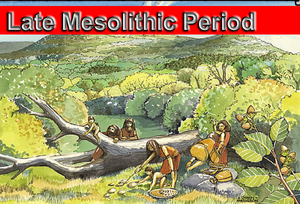| 6,000 BC | |||||
|---|---|---|---|---|---|

| |||||
| Union Time Line | |||||
| |||||
== Earth==
The 6th millennium BC spanned the years 6000 BC to 5001 BC (c. 8 ka to c. 7 ka). It is impossible to precisely date events that happened around the time of this millennium and all dates mentioned here are estimates mostly based on the geological and anthropological analysis. This millennium is reckoned to mark the end of the global deglaciation which had followed the Last Glacial Maximum and caused sea levels to rise by some sixty meters over a period of about 5,000 years.
Communities[]
Neolithic culture and technology had spread from the Near East and into eastern Europe by 6000 BC. Its development in theFar East grew apace and there is increasing evidence through the millennium of its presence in Prehistoric Egypt and the Far East. In much of the world, however, including north and western Europe, people still lived in scattered Palaeolithic hunter-gatherer communities. The world population is believed to have increased sharply, possibly quadrupling, as a result of the Neolithic Revolution. It has been estimated that there were perhaps forty million people worldwide at the end of this millennium, growing to 100 million by the Middle Bronze Age c. 1600 BC.

It has been estimated that humans first settled in Malta c. 5900 BC, arriving across the Mediterranean from both Europe and North Africa.
Evidence of cheese-making in Poland is dated c. 5500 BC.
The Zhaobaogou culture inChina began c. 5400 BC. It was in the north-eastern part of the country, primarily in the Luan River valley in Inner Mongolia and northern Hebei.
Pottery[]
Use of pottery found near Tbilisi is evidence that grapes were being used for winemaking c. 5980 BC.
Environmental changes[]

The early Holocene sea-level rise (EHSLR), which began c.10,000 BC, tailed off during the 6th millennium. Global water levels had risen by about 60 meters due to deglaciation of ice masses since the end of the Last Ice Age.[6] Accelerated rises in sea-level rise, called meltwater pulses, occurred three times during the EHSLR. The last one, Meltwater Pulse 1C, which peaked c. 6000 BC, produced a rise of 6.5 meters in only 140 years. It is believed that the cause was a major ice sheet collapse in Antarctica.
Approximately 8,000 years ago (c. 6000 BC), a massive volcanic landslide off Mount Etna, Sicily, caused a megatsunami that devastated the eastern Mediterranean coastline on the continents of Asia, Africa and Europe.[8]
A cataclysmic volcanic eruption occurred c. 5700 BC in Oregon when 12,000-foot (3,700 m) high Mount Mazama created Crater Lake as the resulting caldera filled with water.[9]
The carbon-14 content in tree rings created c. 5480 BC indicates an abnormal level of solar activity.

Astronomy and calendars[]
Byzantine Calendar illustrating 1 September 5509 BC (the calendar is from the 12th century).
The epoch of the Byzantine calendar, used in the Byzantine Empire and many Christian Orthodox countries, is equivalent to 1 September 5509 BC on the Julian proleptic calendar (see image right).
The 6th millennium BC falls entirely within the zodiacal age of Gemini (c. 6450 BC to c. 4300 BC).
Early proto-cities appeared at Jericho and Catal Huyuk around 6000 BCE

Ancient Civilizations 2 Catal Huyuk
Galaxy and Universe[]
- Atlanteans return to Earth for secret archeological work. They try to find evidence and artifacts of their ancestors occupying Lemuria.
- Kermac-Saresii War begins
- ANarth appears at a Galactic Council meeting but does not speak to anyone, A Kermac delegate insults the Narth, The Kermac is killed by the Narth